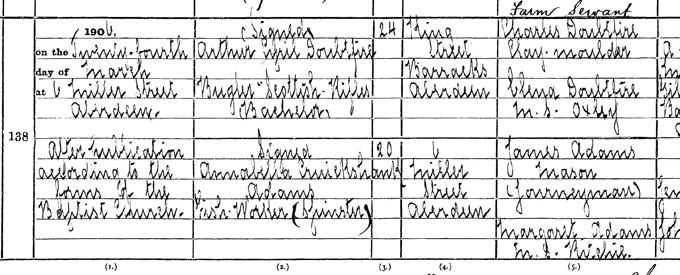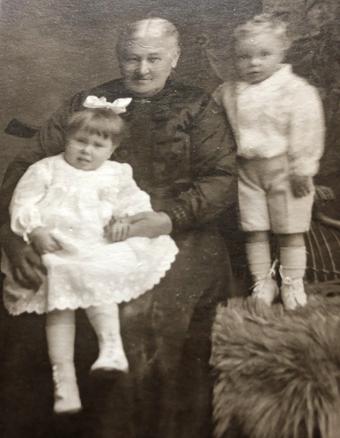Say the name ‘Mrs Doubtfire’ and the character portrayed by the American actor and comedian, Robin Williams in the 1993 film of the same title will be brought to the mind of many. Williams plays a man who, recently divorced from his wife, dresses as a female housekeeper in order to be able to spend time with his children. This character was fictional, created by Anne Fine in her book ‘Madame Doubtfire’, first published in 1987. The title, however, had been inspired by a real person who worked in a shop of the same name in Edinburgh. This article tells the story of the real ‘Madame Doubtfire.’
Annabella Cruickshank Adams was born on 18th December 1886 at 12 Innes Street, Aberdeen. Her parents, John Adams, a stone polisher, and Margaret Ritchie had married six months earlier in Aberdeen.

Detail from the birth entry of Annabella Cruickshank Adams, 18th December 1886
Crown copyright, National Records of Scotland (NRS), Statutory Register of Births, 1886, 168/1 36 page 12
Her father, John, had previously been married. His first wife was a widow named Elizabeth Leslie (maiden surname Ross). They wed on 1st February 1878 in Aberdeen. Their son, Simon Brown Adams, was born later that year, on 26th October. Six years later, Elizabeth died from pneumonia in April 1884, aged 32.
Although never previously married, Annabella’s mother Margaret had a child outside of marriage. The Statutory Register of Birth entries record that on 1st July 1884 she had given birth to a son, John Ritchie.
John and Margaret had two further daughters in the years following Annabella’s birth; Elizabeth, born 1888 in St Nicholas, Aberdeenshire, and Barbara, born 1894 in Dundee, Forfarshire.
The family were enumerated in the 1901 census as living in Barnett’s Close, Aberdeen. Annabella’s name was recorded as ‘Annie B Adams’ – this could have been copied incorrectly at the time of enumeration. She was employed as a fish worker, an occupation that both of her sisters would also work in. Her father, John, was not at home on the night of the census, and so her mother is listed as ‘Head’ of the household.

The Adams family enumerated in the 1901 census
Crown copyright, NRS, 1901 census, 168/1 3/1
On 24th March 1906, aged 20 years old, Annabella married Arthur Cyril Doubtfire, a 24-year-old bugler in the Scottish Rifles. They were wed in the Adams’ family home at 6 Miller Street, Aberdeen.

Detail from the marriage entry of Arthur Doubtfire and Annabella Cruickshank Adams
Crown copyright, NRS Statutory Register of Marriages, 1906, 168/1 138 page 69
Born in Bermondsey, Greater London, in January 1882, Arthur was the son of Charles Doubtfire and Ellen Oxley. The English census records that Arthur and Annabella were living in Colchester, Essex, by 1911.
Arthur served in the Cameronians (Scottish Rifles) for 12 years and rose from private (bugler) to Acting Company Serjeant Major. At the outbreak of the First World War, he was deployed to France before serving in the British Salonika Force with the 26th division, 77th brigade, 11th battalion Cameronians. Arthur died in Thessaloníki (Salonika), Greece, in the Macedonian campaign on 20th November 1916 and is buried in Kristoni, in the Macedonia region of Greece. The inscription on his grave reads ‘rest in peace sweetheart, we will meet again, inserted by his sorrowing wife.’ [Source: Find a Grave].
Annabella returned to Scotland, to live in Edinburgh.

A photograph of Annabella.
Credit: courtesy of Arthur and Marjory Carnegie
The 1921 census records her as a 34 year old widowed broker living at 3 South East Circus Place, Edinburgh, in a house with one room inhabiting three persons. Staying with Annabella on the night of 19th June was her mother Margaret Adams, now widowed, and George Noble, Annabella's nephew.

Detail from the 1921 census enumerating Annabella Doubtfire. Her name can be seen on the seventh entry down.
Crown copyright, NRS, 1921 census, 685/2 44 page 11
The following month, Annabella married James Davie (JD) Coutts at 8 Bank Street, Edinburgh, in the presence of Robert Todd, an engine fitters labourer, and William Young, a taxi proprietor. This was termed an ‘irregular marriage’ in which a man and woman made a declaration in front of two witnesses. By showing proofs of their marriage, the parties could obtain a warrant from a sheriff or sheriff substitute to have the marriage registered by the local registrar. This form of marriage ceased to be a legal way to marry from 1st July 1940 when civil marriage was introduced.
James was born on 29th January 1893 in Dundee, Forfarshire, to John Baillie Coutts, flax warehouseman, and Elizabeth McDonald. His marriage to Annabella was his second; he had married once before, to Ethel Massan, on 11th April 1914 in York, England. The marriage was an unhappy one, and James had appealed to the Court of Session for a divorce on the grounds of adultery (NRS, CS244/1903). The couple had married when James, employed by the British Army, was stationed in York. Following the outbreak of war, he was sent to France. Upon his return, James discovered that Ethel was pregnant and she subsequently gave birth to a still born baby. Despite James’ efforts in trying to reconcile their relationship, Ethel committed adultery on a number of occasions, eventually giving birth to two children as a result of her extra marital relationships in 1916 and 1918. Divorce was granted on 9th July 1921, two weeks before James wed Annabella.

Detail from the marriage of James Davie Coutts and Annabella Doubtfire
Crown copyright, NRS, Statutory Register of Marriages, 1921, 685/4 886 page 443
Coutts had attested for the Army in Glasgow on 10th October 1911 aged 17 years old, when he was working as a labourer in Dundee. He was awarded the 1914-15 Star – a campaign medal of the British Empire which was presented to officers and men who served in any theatre of the First World War during 1914 and 1915 – and the Victory Medal.

An example of the reverse of the Victory Medal
Credit: Wikimedia, Public Domain image
Passenger immigration lists reveal that James spent time abroad. Two years after his marriage, he set sail aboard the S. S. Marloch on 10th August 1923 to work as a groom (stable hand). Originally travelling to Hamilton, Ontario, he arrived in Detroit, America in September 1923 to work as a labourer, living at 1135 Pallister Avenue. It is not clear when or where he died or whether he lived with Annabella for any particular period of time.
By 1925, Annabella was still renting and living at South East Circus Place, as recorded in the valuation rolls. In addition to this property, she rented and occupied a stable, coach house and loft on Circus Lane; owned a house at 20a Fettes Row (where she was noted to be a furniture dealer); and rented a shop at 36c Lauriston Place.
In 1931, Annabella purchased the shops and houses at 1 and 3 South East Circus Place. This property forms part of a significant surviving section of one of the most important and best preserved examples of urban planning in Britain. The eminent architect W H Playfair drew up plans for the area in 1820, which were part of the first extension of the New Town. Because of their architectural and historical significance, they were recorded as a ‘Category A’ listed buildings in September 1966.
Annabella’s shop, nestled amongst these beautiful regency sandstone buildings, would become the establishment ‘Madame Doubtfire’.

The outside of the building as it appears today
Credit: Crown copyright
Margaret Adams, Annabella’s mother, died on 26th July 1948 at Annabella’s home, aged 86. Annabella signed the death entry ‘A Doubtfire’ – the name she would call herself for much of the rest of her adult life, rather than her married name of ‘Coutts’. Her father, John Adams, had died decades earlier, in the Aberdeen Poorhouse on 17th August 1913 from ‘morbus cordis’ – an unspecified heart disease.

Margaret Adam’s death entry
Crown copyright, NRS, Statutory Register of Deaths, 1948, 685/2 376 page 126

Margaret Adams with her great grandchildren.
Credit: Courtesy of Arthur and Marjory Carnegie
Annabella was often seen sitting outside her second-hand clothes and antiques shop, surrounded by cats, as she smoked a clay pipe. It was said that aristocrats would visit her shop during the depression and would pawn their items to her, resulting in a selection of high end garments for sale. (Aberdeen Evening Express, 8th January 1994). Contemporary adverts in newspapers exhibited the wide array of goods available, including ‘attractive evening and day dresses, evening coats and cloaks, slippers [and] fur coats’ (Edinburgh Evening News, 27th December 1939).
The atmosphere of the shop was captured by Richard Edmonds in November 1977 in an article detailing some of the architectural delights of Edinburgh for the Birmingham Daily Post: ‘…In a run-down basement I found a sign which read ‘Madame Doubtfire – Ladies and Gents’ Wardrobes, Antique and Modern.’ With its seedy plum-coloured façade peeling and flaking among the cobbles, it had a strength totally absent from the brash supermarket which stood nearby.’
Annabella closed her shop in 1974, selling it the next year, and lived the rest of her life in a retirement home in Edinburgh. She died aged 92 on 22nd November 1979 in hospital in Edinburgh from kidney failure.